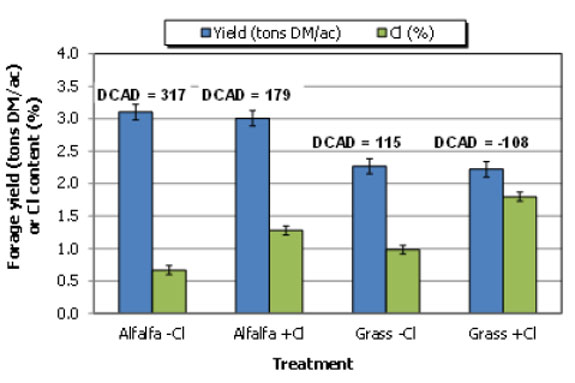Charbonneau et al. reported that lowering DCAD from +300 mEq/kg to 0 mEq per kg reduced the predicted risk for clinical milk fever from 16.4 to 3.2 percent.
There are three basic approaches to manage DCAD:
1. Establish dedicated low fertility fields (low soil test K) for dry cow forage production where manure is not applied
2. Adjust ration DCAD with minerals
3. Fertilize forages with chloride.
Many dairy farms use a combination of the first and second approaches. Dedicating acres to dry cow forage production makes sense, but depending on your storage set up, it may not be practical to separate fields unless you bag all of your haylage.
At the Institute, we use a mix of bags and bunkers and separate dry cow haylage from lactating haylage.
However, since our dry cow feed comes from a range of fields, DCAD levels vary and we must add minerals to lower DCAD.
In the ideal world, a farm would have sufficient low K fields to produce the needed dry cow forage and the ability to store and feed all of it separately.
Although less common, chloride application can also effectively lower DCAD levels. Research at Miner Institute previously demonstrated that a one-time application of 50 lbs per acre of chloride (as urea calcium chloride) to reed canarygrass reduced DCAD levels by 45 percent for first cutting.
Last year we tested whether a onetime addition of 70 lb/acre of chloride (as liquid calcium chloride) could effectively reduce DCAD of both alfalfa-grass and grass over a wide range of soil fertility. Three replicate plots were established on grass and alfalfa-grass fields at each of four sites.
Chloride was applied at green-up following first cut harvest. Plots were harvested near the third week of June 2010 (second cut) and again near the end of July (third cut).

Chloride addition nearly doubled the Cl content of the forage and significantly reduced DCAD (see Figure 1).
Results were similar for the next cutting and there were no negative impacts on yield or other forage quality measures. Results suggest that chloride fertilization is a good option for managing DCAD. While mineral addition to the ration seems easier, fertilizing forages in the field may produce more palatable feed.
In addition, work is needed on the economics of fertilizing forages with chloride versus ration supplementation. Stay tuned. FG
—Excerpts from Miner Institute Farm Report, May 2011
Research is omitted due to space but available upon request.








